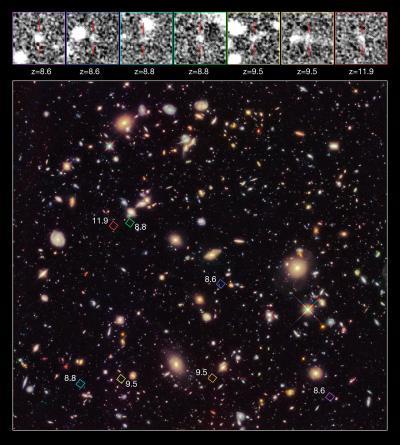Astronomers using the NASA/ESA Hubble Space Telescope have uncovered seven primitive galaxies from a distant population that formed more than 13 billion years ago. In the process, their observations have put forward a candidate for the record for the most distant galaxy found to date (at redshift 11.9), and have shed new light on the earliest years of cosmic history. The galaxies are seen as they were when the Universe was less than 4 percent of its present age.
A team of scientists using the Hubble Space Telescope has made new observations of the Hubble Ultra Deep Field (see [heic0406][1], [heic0916][2]), as part of a project to improve our understanding of the early years of the Universe.
The resulting images offer the deepest ever view of the Universe at near-infrared wavelengths, which capture the redshifted [1] light of early galaxies. Because light takes so long to travel from these remote objects, astronomers are looking back in time, seeing these galaxies as they appeared 600 million years after the Big Bang (the Universe is now 13.7 billion years old). One object spotted by the team may be the most distant ever observed.
The new data have allowed the team, co-led by Richard Ellis (Caltech, USA) and Ross McLure (University of Edinburgh, UK), to uncover six previously-unknown galaxies in this era, and to rule out a number of tentative identifications of distant galaxies made by other scientists in previous research. This is the first statistically robust census of galaxies at such an early time in cosmic history, and shows that the number of galaxies steadily increased with time, supporting the idea that the first galaxies didn't form in a sudden burst but gradually assembled their stars.
One previously-claimed candidate extreme redshift galaxy in the Hubble Ultra Deep Field was confirmed by the team. This is UDFj-39546284, for a while claimed to be the most distant known galaxy, at redshift 10 ([heic1103][3]). However, the improved and extended dataset has allowed the scientists to shed unexpected new light on this object, showing that it either lies at an even greater distance than previously thought (at a redshift of 11.9, handing it back the distance record), or must otherwise be a previously unknown type of extreme emission-line galaxy at much lower redshift [2].
"Our study has taken the subject forward in two ways," says Ellis. "First, we have used Hubble to make longer exposures than previously. The added depth is essential to reliably probe the early period of cosmic history. Second, we have used Hubble's available colour filters very effectively to measure galaxy distances more precisely."

This image shows the Hubble Ultra Deep Field 2012, an improved version of the Hubble Ultra Deep Field image featuring additional observation time. The new data have revealed for the first time a population of distant galaxies at redshifts between 9 and 12, including the most distant object observed to date. These galaxies are shown at the top of the picture, and their locations are pinpointed in the main image.
These galaxies will require confirmation using spectroscopy by the forthcoming NASA/ESA/CSA James Webb Space Telescope before they are considered to be fully confirmed.
(Photo Credit: NASA, ESA, R. Ellis (Caltech), and the HUDF 2012 Team)
Studying galaxies in the early years of the Universe is fraught with difficulties. Scientists are working at the very limits of what Hubble is capable of, and must grapple with sometimes ambiguous data. A number of tentative identifications of distant galaxies have been disproved in the past, and this project is designed in part to improve the quality of data available [3].
Part of this involves taking additional data through filters which have already been used to take deep images of the Hubble Ultra Deep Field, but the team has also added new imaging through previously unexploited filters. "We added an additional filter, and undertook much deeper exposures in some filters than in earlier work in order to convincingly reject the possibility that some of our galaxies might be foreground objects," said team member James Dunlop (University of Edinburgh, UK).
The observations, part of a project called Hubble Ultra Deep Field 2012 (UDF 2012), were made over a period of six weeks during August and September 2012, and the first results are now appearing in a series of scientific papers. The UDF 2012 team is publicly releasing these unique data before the end of the year, after preparing them for other research groups to use.
A major goal of the new program was to determine how rapidly the number of galaxies increased over time in the early Universe. This measure is the key evidence for how quickly galaxies build up their constituent stars.
"This discovery of a significant population of galaxies at redshifts greater than 8, coupled with our new analysis of the number and properties of galaxies at redshift 7 and 8, support the idea that galaxies assembled progressively over time," said the project co-leader Ross McLure (University of Edinburgh, UK).
The results from the UDF 2012 campaign suggest there will be many undiscovered galaxies even deeper in space waiting to be revealed by the forthcoming James Webb Space Telescope, which will be launched in 2018.
The team's finding on the distant galaxy census has been accepted for publication in The Astrophysical Journal Letters.
Source: ESA/Hubble Information Centre